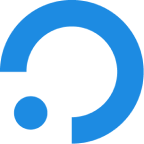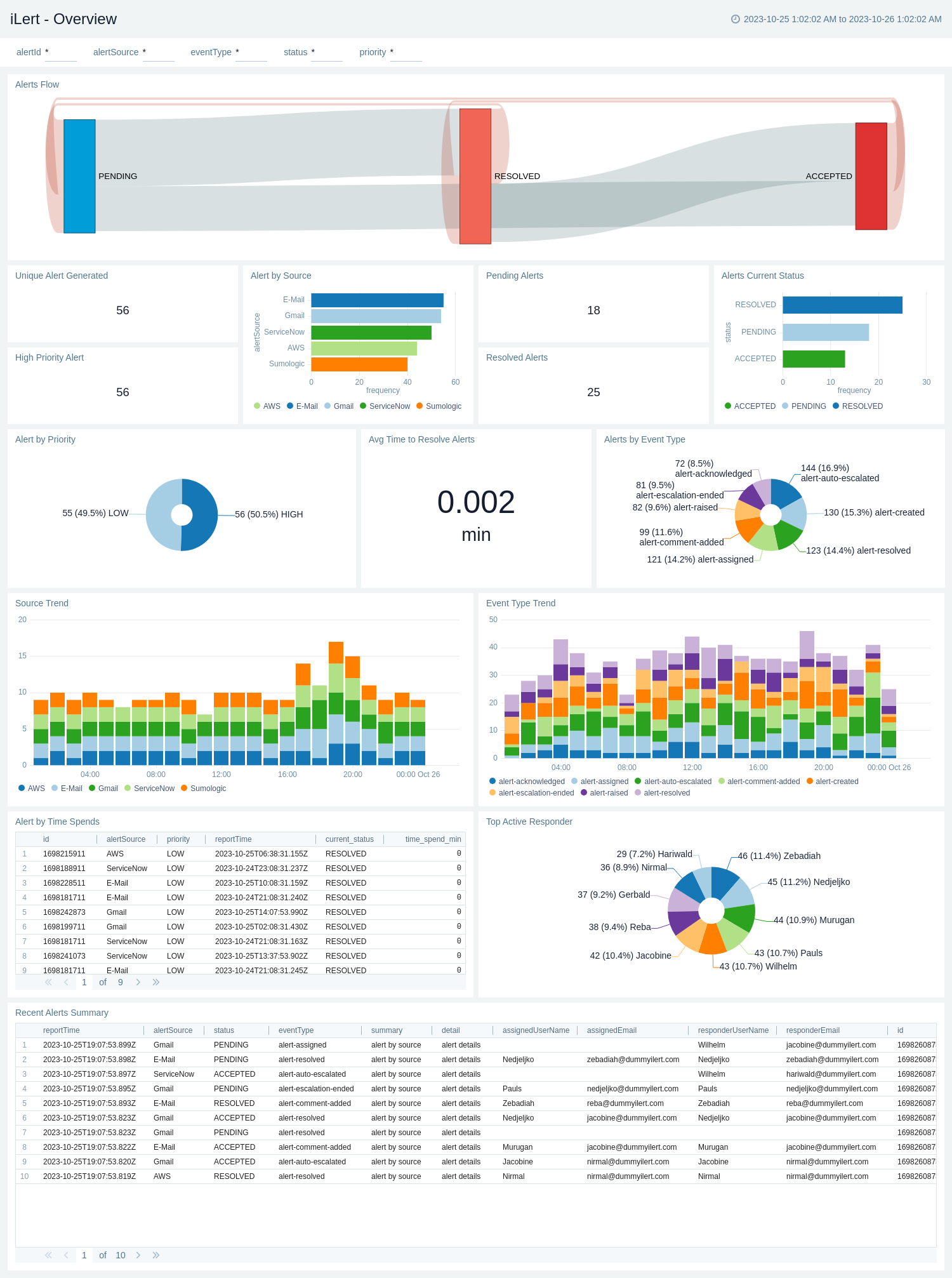iLert

The iLert app for Sumo Logic enables efficient integration of the alert management system with Sumo Logic's robust analytics platform. The provided dashboard panels offer comprehensive insights, including tracking Unique Alert Generation, categorizing alerts by source and priority (highlighting high-priority ones), monitoring Pending and Resolved Alerts, and assessing overall alert status. Users can identify top active responders, analyze alerts based on event type and source trends, and stay informed with a concise summary of recent alerts. This integration enhances alert management and incident response capabilities, providing a powerful solution for effective monitoring and analysis.
iLert is a platform for alerting, on-call management and status pages. You can use a webhook in the iLert platform to forward alert events to the Sumo Logic HTTP endpoint. Using these logs, you can monitor the lifecycle of alerts, from creation and acceptance to re-routing, escalation, and resolution, while also tracking responder actions and channel attachments for effective incident management in Sumo Logic. For more details, refer to the iLert Documentation.
Event types
The Sumo Logic integration for iLert ingests alert events into Sumo Logic through an outgoing webhook available in iLert. The following event types are ingested through the webhook:
- Alert created
- Alert accepted
- Alert re-routed
- Alert escalated
- Alert priority raised
- Alert resolved
- Alert comment added
- Responder added to alert
- Responder removed from alert
- Channel attached to alert
- Channel detached from alert
Sample log messages
{
"id": "1698262673",
"summary": "alert by source",
"details": "alert details",
"reportTime": "2023-10-25T19:37:53.833Z",
"status": "ACCEPTED",
"eventType": "alert-auto-escalated",
"priority": "HIGH",
"alertKey": "c4He8Qfa5Ysk",
"alertSource": {
"id": 2252825,
"name": "E-Mail"
},
"assignedTo": {
"id": 2241338,
"username": "Nedjeljko",
"firstName": "Priyansh",
"lastName": "Patel",
"email": "zebadiah@dummyilert.com"
},
"responders": [
{
"user": {
"id": 2241338,
"username": "Nedjeljko",
"firstName": "Priyansh",
"lastName": "Patel",
"email": "zebadiah@dummyilert.com"
},
"status": "ACCEPTED"
}
]
}
Sample queries
_sourceCategory="webhook/ilert"
| json "id", "summary", "details", "reportTime", "status", "eventType", "priority", "alertSource.name", "assignedTo.username", "assignedTo.email", "responders[0].user.username", "responders[0].user.email" as id, summary, detail, reportTime, status, eventType, priority, alertSource, assignedUserName, assignedEmail, responderUserName, responderEmail nodrop
| where id matches "{{alertId}}" and alertSource matches "{{alertSource}}" and eventType matches "{{eventType}}" and status matches "{{status}}" and priority matches "{{priority}}"
| count_distinct(id)
Setup
This section has instructions for collecting logs for the Sumo Logic iLert webhook collection.
Source configuration
Follow the below steps to configure the Hosted Collector to receive iLert events:
- In the Sumo Logic portal, create a new Hosted Collector or use an existing one. Then add a HTTP Logs and Metrics Source.
- Configure Source Category in the HTTP Source - for example,
webhook/ilert- for the iLert integration. - Copy and save the endpoint URL of the source.
Vendor configuration
Configure the webhook integration in iLert to send events to the Sumo Logic HTTP source. Once configured, it will be triggered each time the events occur within your iLert account.
Follow the steps to configure the iLert Webhook.
- Sign in to the iLert account.
- Select Alert sources from the Alert Sources dropdown menu.
- Select the alert source for which you want to send events to Sumo Logic.
- Go to Alert actions. Click on Create a new alert action.
- Select Webhook as the type. The webhook form appears.
- Enter webhook form data as follows:
- Trigger mode. Select Automatic.
- Filter alert events. Select the event types for which you want to send notifications to Sumo Logic.
- URL. Enter the Sumo Logic HTTP endpoint URL (source address) created above.
- Conditional execution. Select Execute this alert action for all alerts. You can even specify any specific condition if required.
- Click Save.
- Verify iLert events are getting ingested in Sumo Logic by executing the following query on Sumo Logic's Log Search panel.
`_sourceCategory=webhook/ilert`
- For detailed information about webhook creation, refer to the iLert Documentation.
- For support, contact iLert.
Installing the iLert app
To install the app, do the following:
Next-Gen App: To install or update the app, you must be an account administrator or a user with Manage Apps, Manage Monitors, Manage Fields, Manage Metric Rules, and Manage Collectors capabilities depending upon the different content types part of the app.
- Select App Catalog.
- In the 🔎 Search Apps field, run a search for your desired app, then select it.
- Click Install App.
note
Sometimes this button says Add Integration.
- Click Next in the Setup Data section.
- In the Configure section of your respective app, complete the following fields.
- Field Name. If you already have collectors and sources set up, select the configured metadata field name (eg _sourcecategory) or specify other custom metadata (eg: _collector) along with its metadata Field Value.
- Click Next. You will be redirected to the Preview & Done section.
Post-installation
Once your app is installed, it will appear in your Installed Apps folder, and dashboard panels will start to fill automatically.
Each panel slowly fills with data matching the time range query received since the panel was created. Results will not immediately be available but will be updated with full graphs and charts over time.
Viewing iLert dashboards
All dashboards have a set of filters that you can apply to the entire dashboard. Use these filters to drill down and examine the data to a granular level.
- You can change the time range for a dashboard or panel by selecting a predefined interval from a drop-down list, choosing a recently used time range, or specifying custom dates and times. Learn more.
- You can use template variables to drill down and examine the data on a granular level. For more information, see Filtering Dashboards with Template Variables.
- Most Next-Gen apps allow you to provide the scope at the installation time and are comprised of a key (
_sourceCategoryby default) and a default value for this key. Based on your input, the app dashboards will be parameterized with a dashboard variable, allowing you to change the dataset queried by all panels. This eliminates the need to create multiple copies of the same dashboard with different queries.
Overview
The iLert - Overview dashboard presents a comprehensive insight into the alert management system, featuring a range of informative panels. Starting with Unique Alert Generation statistics, it displays alerts categorized by their sources and highlights High-Priority alerts for immediate attention. The dashboard also tracks Pending and Resolved Alerts, providing a real-time overview of the alert status. Additionally, it offers a breakdown of alerts by priority, identifies the Top Active Responders, and analyses alert data based on event types and source trends. Users can efficiently spot event-type trends and review a concise summary of recent alerts.

Upgrade/Downgrade the iLert app (Optional)
To update the app, do the following:
Next-Gen App: To install or update the app, you must be an account administrator or a user with Manage Apps, Manage Monitors, Manage Fields, Manage Metric Rules, and Manage Collectors capabilities depending upon the different content types part of the app.
- Select App Catalog.
- In the Search Apps field, search for and then select your app.
Optionally, you can identify apps that can be upgraded in the Upgrade available section. - To upgrade the app, select Upgrade from the Manage dropdown.
- If the upgrade does not have any configuration or property changes, you will be redirected to the Preview & Done section.
- If the upgrade has any configuration or property changes, you will be redirected to the Setup Data page.
- In the Configure section of your respective app, complete the following fields.
- Field Name. If you already have collectors and sources set up, select the configured metadata field name (eg _sourcecategory) or specify other custom metadata (eg: _collector) along with its metadata Field Value.
- Click Next. You will be redirected to the Preview & Done section.
Post-update
Your upgraded app will be installed in the Installed Apps folder and dashboard panels will start to fill automatically.
See our Release Notes changelog for new updates in the app.
To revert the app to a previous version, do the following:
- Select App Catalog.
- In the Search Apps field, search for and then select your app.
- To version down the app, select Revert to < previous version of your app > from the Manage dropdown.
Uninstalling the iLert app (Optional)
To uninstall the app, do the following:
- Select App Catalog.
- In the 🔎 Search Apps field, run a search for your desired app, then select it.
- Click Uninstall.